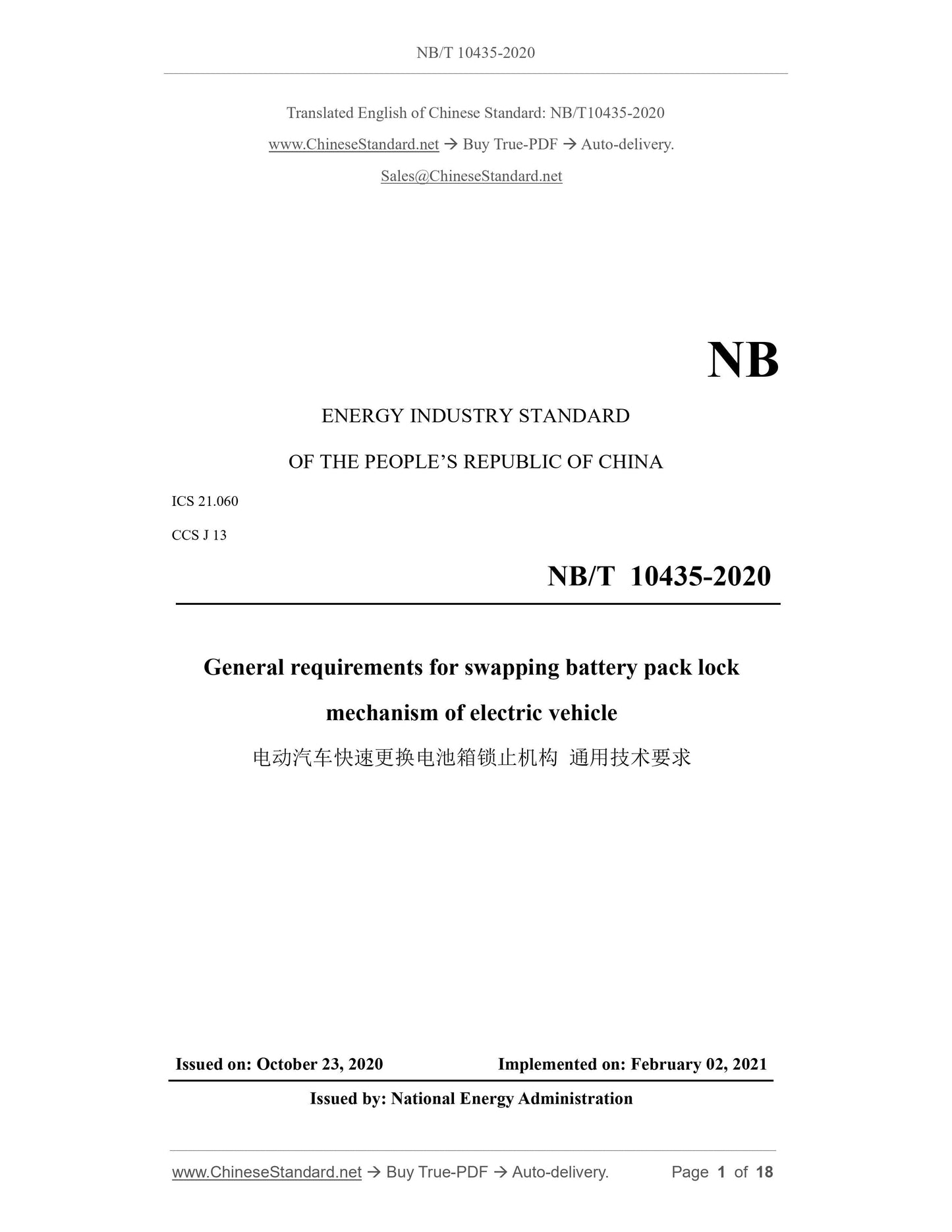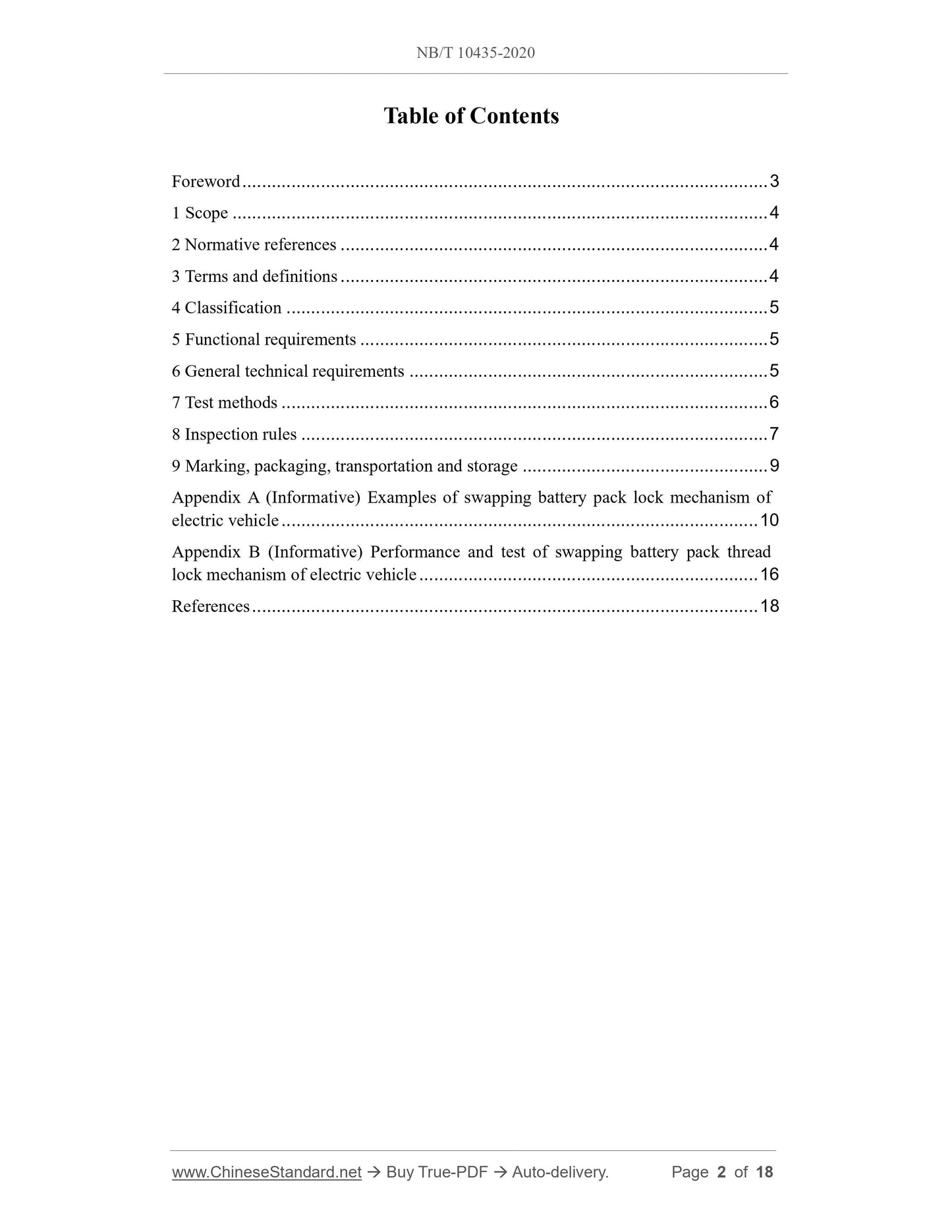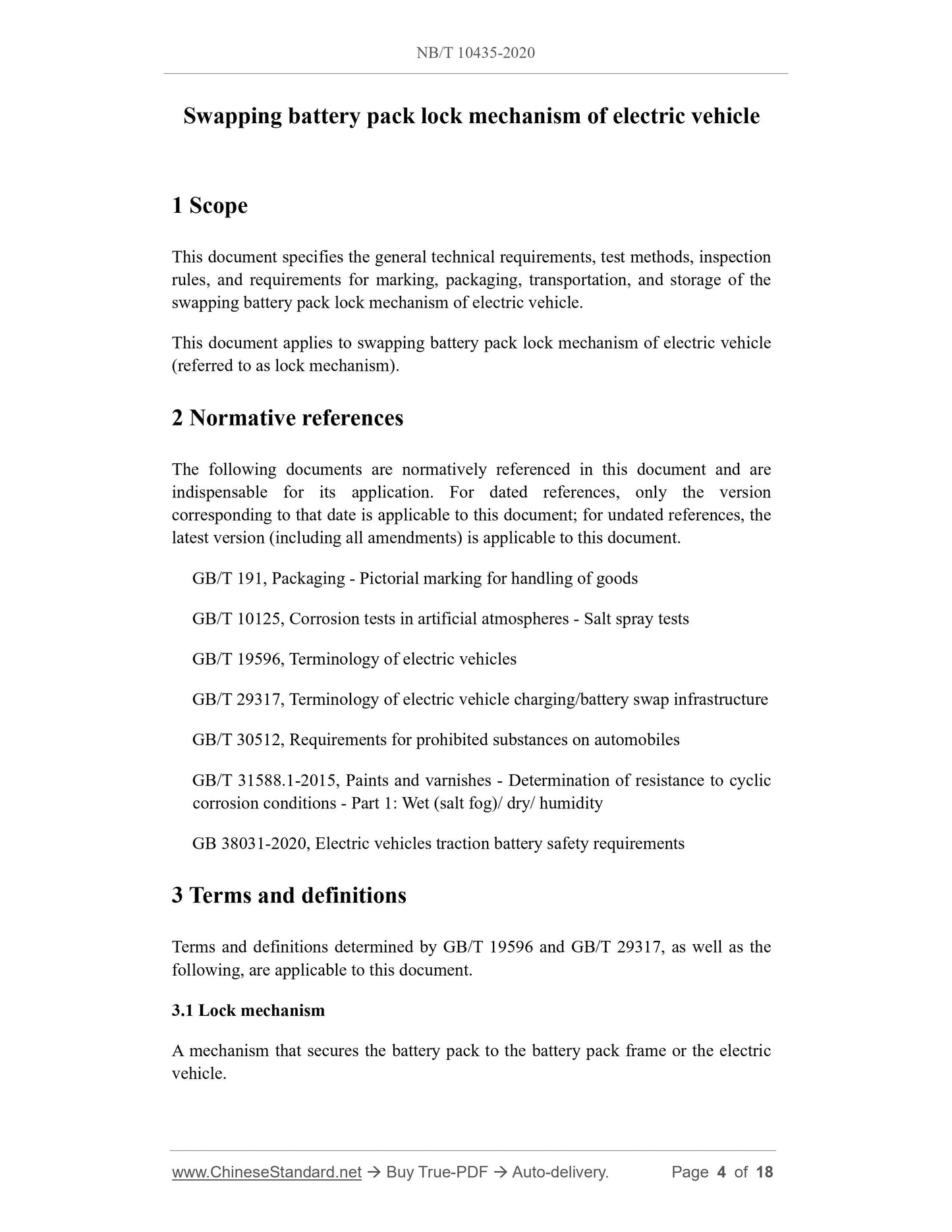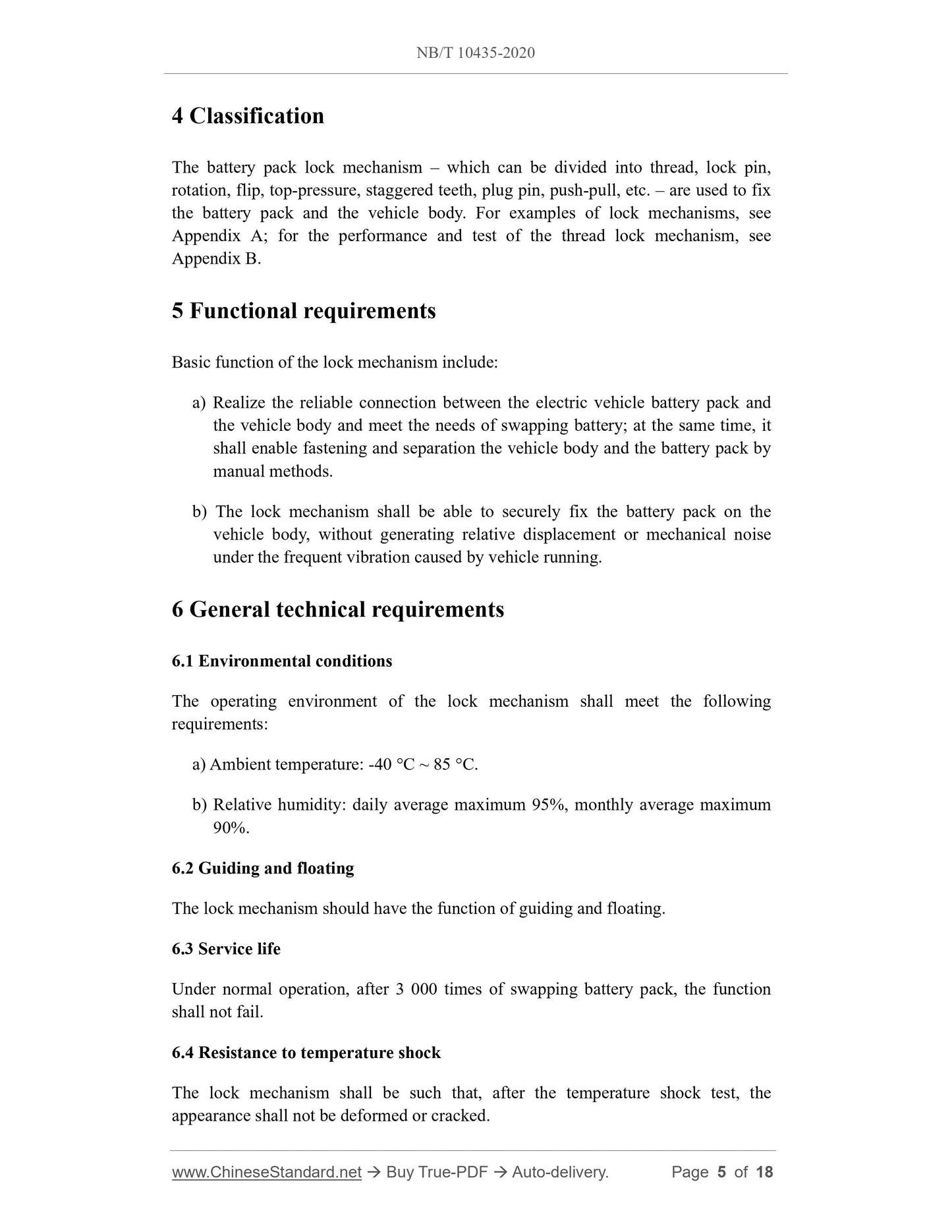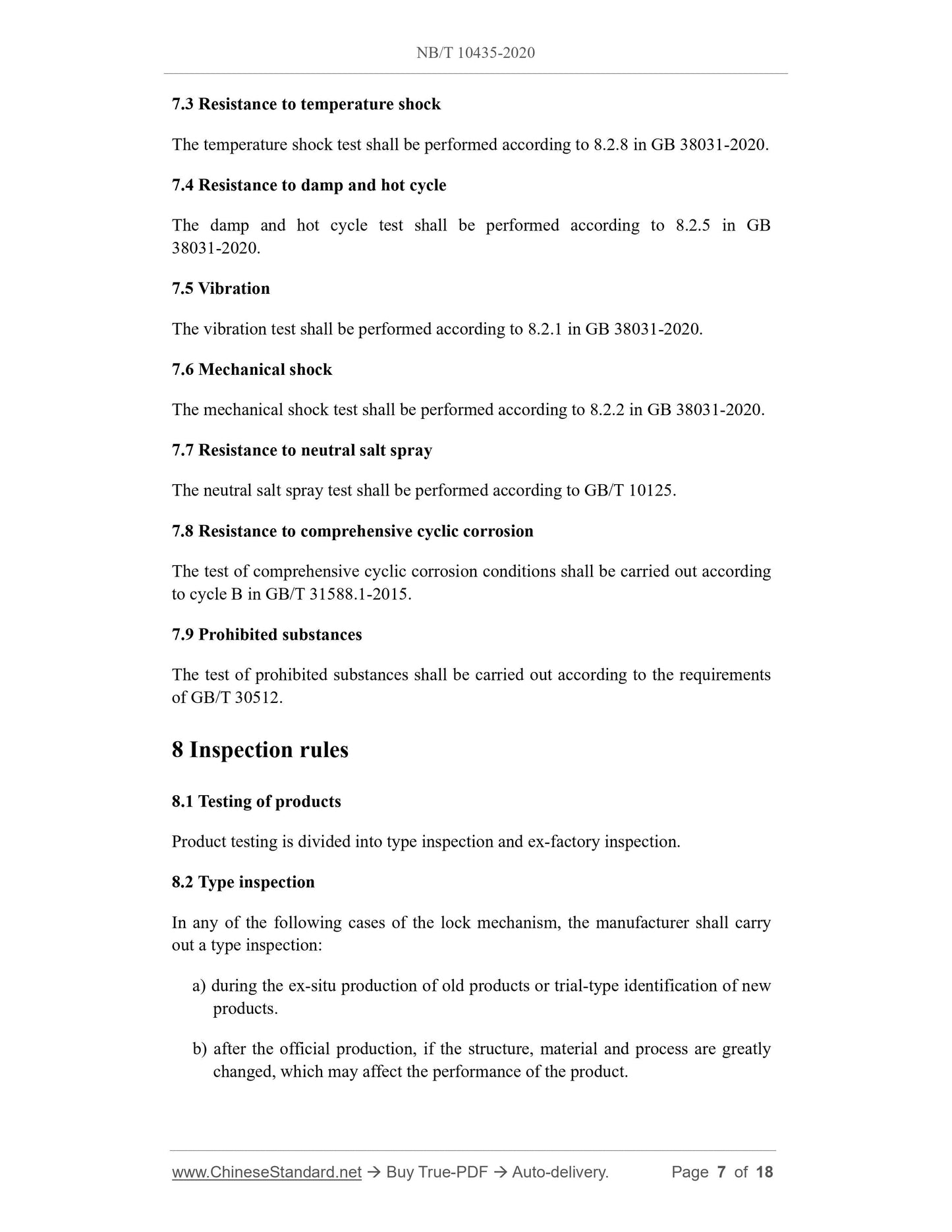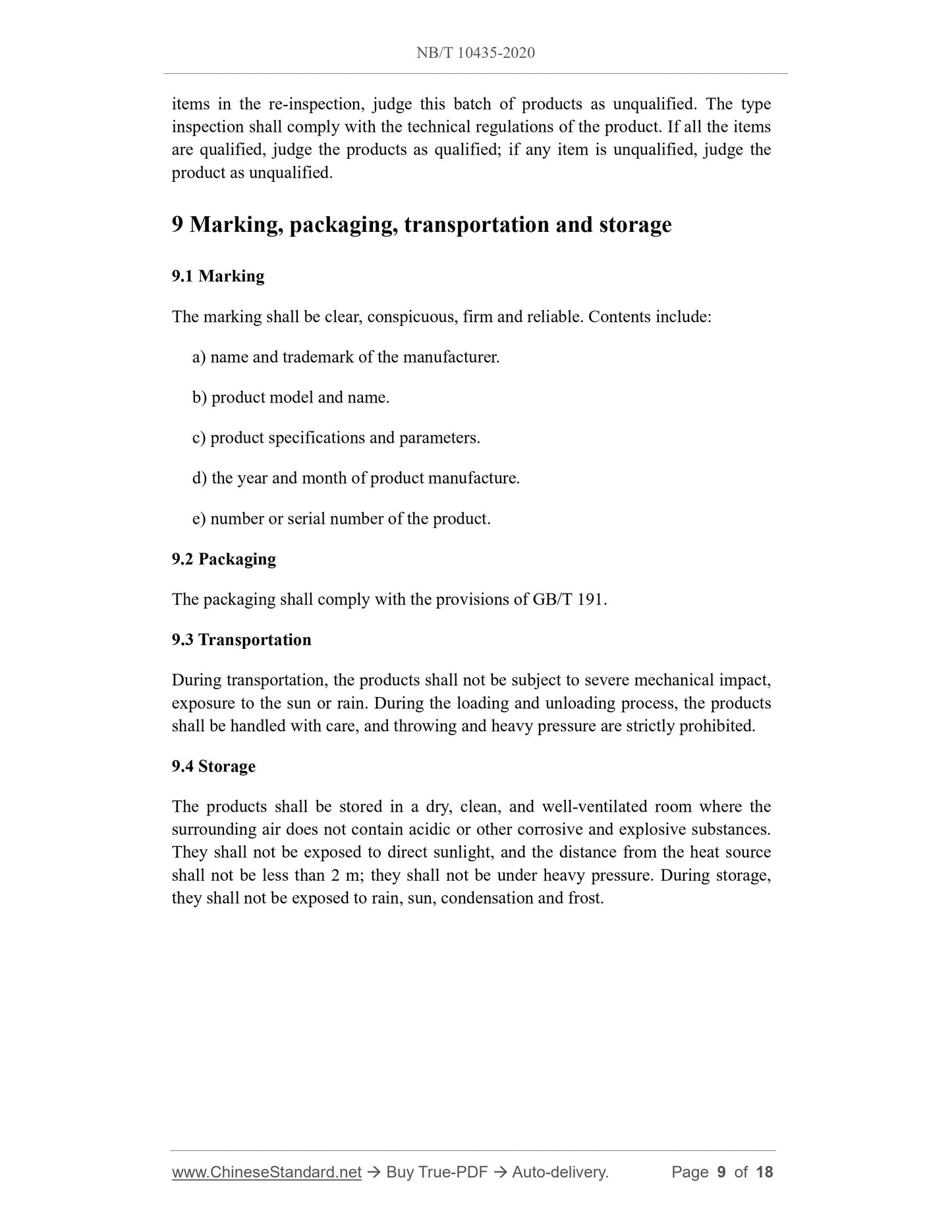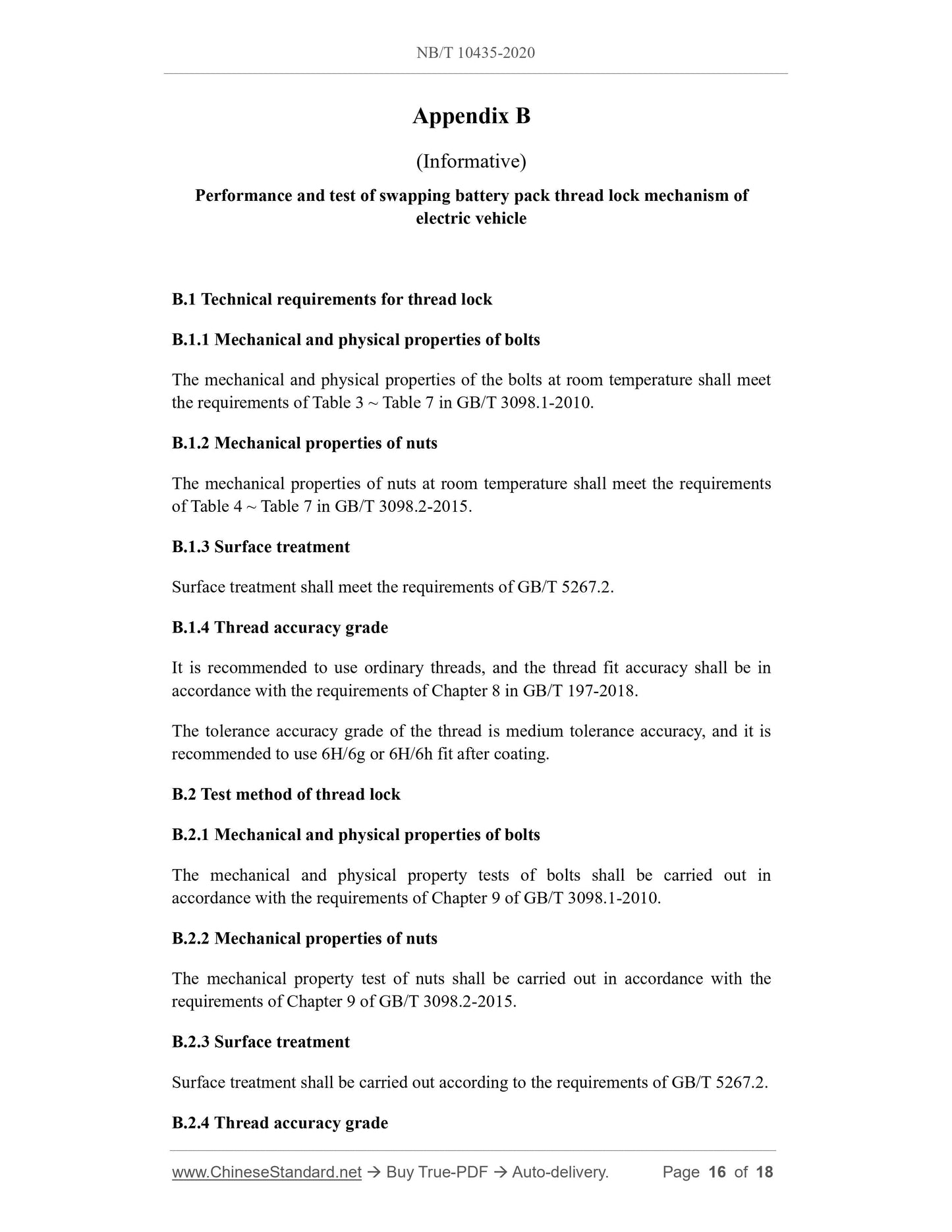1
/
of
7
www.ChineseStandard.us -- Field Test Asia Pte. Ltd.
NB/T 10435-2020 English PDF (NB/T10435-2020)
NB/T 10435-2020 English PDF (NB/T10435-2020)
Regular price
$305.00
Regular price
Sale price
$305.00
Unit price
/
per
Shipping calculated at checkout.
Couldn't load pickup availability
NB/T 10435-2020: General requirements for swapping battery pack lock mechanism of electric vehicle
Delivery: 9 seconds. Download (& Email) true-PDF + Invoice.
Get Quotation: Click NB/T 10435-2020 (Self-service in 1-minute)
Historical versions (Master-website): NB/T 10435-2020
Preview True-PDF (Reload/Scroll-down if blank)
NB/T 10435-2020
NB
ENERGY INDUSTRY STANDARD
OF THE PEOPLE’S REPUBLIC OF CHINA
ICS 21.060
CCS J 13
General requirements for swapping battery pack lock
mechanism of electric vehicle
ISSUED ON: OCTOBER 23, 2020
IMPLEMENTED ON: FEBRUARY 02, 2021
Issued by: National Energy Administration
Table of Contents
Foreword ... 3
1 Scope ... 4
2 Normative references ... 4
3 Terms and definitions ... 4
4 Classification ... 5
5 Functional requirements ... 5
6 General technical requirements ... 5
7 Test methods ... 6
8 Inspection rules ... 7
9 Marking, packaging, transportation and storage ... 9
Appendix A (Informative) Examples of swapping battery pack lock mechanism of
electric vehicle ... 10
Appendix B (Informative) Performance and test of swapping battery pack thread
lock mechanism of electric vehicle ... 16
References ... 18
Swapping battery pack lock mechanism of electric vehicle
1 Scope
This document specifies the general technical requirements, test methods, inspection
rules, and requirements for marking, packaging, transportation, and storage of the
swapping battery pack lock mechanism of electric vehicle.
This document applies to swapping battery pack lock mechanism of electric vehicle
(referred to as lock mechanism).
2 Normative references
The following documents are normatively referenced in this document and are
indispensable for its application. For dated references, only the version
corresponding to that date is applicable to this document; for undated references, the
latest version (including all amendments) is applicable to this document.
GB/T 191, Packaging - Pictorial marking for handling of goods
GB/T 10125, Corrosion tests in artificial atmospheres - Salt spray tests
GB/T 19596, Terminology of electric vehicles
GB/T 29317, Terminology of electric vehicle charging/battery swap infrastructure
GB/T 30512, Requirements for prohibited substances on automobiles
GB/T 31588.1-2015, Paints and varnishes - Determination of resistance to cyclic
corrosion conditions - Part 1: Wet (salt fog)/ dry/ humidity
GB 38031-2020, Electric vehicles traction battery safety requirements
3 Terms and definitions
Terms and definitions determined by GB/T 19596 and GB/T 29317, as well as the
following, are applicable to this document.
3.1 Lock mechanism
A mechanism that secures the battery pack to the battery pack frame or the electric
vehicle.
4 Classification
The battery pack lock mechanism – which can be divided into thread, lock pin,
rotation, flip, top-pressure, staggered teeth, plug pin, push-pull, etc. – are used to fix
the battery pack and the vehicle body. For examples of lock mechanisms, see
Appendix A; for the performance and test of the thread lock mechanism, see
Appendix B.
5 Functional requirements
Basic function of the lock mechanism include:
a) Realize the reliable connection between the electric vehicle battery pack and
the vehicle body and meet the needs of swapping battery; at the same time, it
shall enable fastening and separation the vehicle body and the battery pack by
manual methods.
b) The lock mechanism shall be able to securely fix the battery pack on the
vehicle body, without generating relative displacement or mechanical noise
under the frequent vibration caused by vehicle running.
6 General technical requirements
6.1 Environmental conditions
The operating environment of the lock mechanism shall meet the following
requirements:
a) Ambient temperature: -40 °C ~ 85 °C.
b) Relative humidity: daily average maximum 95%, monthly average maximum
90%.
6.2 Guiding and floating
The lock mechanism should have the function of guiding and floating.
6.3 Service life
Under normal operation, after 3 000 times of swapping battery pack, the function
shall not fail.
6.4 Resistance to temperature shock
The lock mechanism shall be such that, after the temperature shock test, the
appearance shall not be deformed or cracked.
7.3 Resistance to temperature shock
The temperature shock test shall be performed according to 8.2.8 in GB 38031-2020.
7.4 Resistance to damp and hot cycle
The damp and hot cycle test shall be performed according to 8.2.5 in GB
38031-2020.
7.5 Vibration
The vibration test shall be performed according to 8.2.1 in GB 38031-2020.
7.6 Mechanical shock
The mechanical shock test shall be performed according to 8.2.2 in GB 38031-2020.
7.7 Resistance to neutral salt spray
The neutral salt spray test shall be performed according to GB/T 10125.
7.8 Resistance to comprehensive cyclic corrosion
The test of comprehensive cyclic corrosion conditions shall be carried out according
to cycle B in GB/T 31588.1-2015.
7.9 Prohibited substances
The test of prohibited substances shall be carried out according to the requirements
of GB/T 30512.
8 Inspection rules
8.1 Testing of products
Product testing is divided into type inspection and ex-factory inspection.
8.2 Type inspection
In any of the following cases of the lock mechanism, the manufacturer shall carry
out a type inspection:
a) during the ex-situ production of old products or trial-type identification of new
products.
b) after the official production, if the structure, material and process are greatly
changed, which may affect the performance of the product.
items in the re-inspection, judge this batch of products as unqualified. The type
inspection shall comply with the technical regulations of the product. If all the items
are qualified, judge the products as qualified; if any item is unqualified, judge the
product as unqualified.
9 Marking, packaging, transportation and storage
9.1 Marking
The marking shall be clear, conspicuous, firm and reliable. Contents include:
a) name and trademark of the manufacturer.
b) product model and name.
c) product specifications and parameters.
d) the year and month of product manufacture.
e) number or serial number of the product.
9.2 Packaging
The packaging shall comply with the provisions of GB/T 191.
9.3 Transportation
During transportation, the products shall not be subject to severe mechanical impact,
exposure to the sun or rain. During the loading and unloading process, the products
shall be handled with care, and throwing and heavy pressure are strictly prohibited.
9.4 Storage
The products shall be stored in a dry, clean, and well-ventilated room where the
surrounding air does not contain acidic or other corrosive and explosive substances.
They shall not be exposed to direct sunlight, and the distance from the heat source
shall not be less than 2 m; they shall not be under heavy pressure. During storage,
they shall not be exposed to rain, sun, condensation and frost.
Appendix B
(Informative)
Performance and test of swapping battery pack thread lock mechanism of
electric vehicle
B.1 Technical requirements for thread lock
B.1.1 Mechanical and physical properties of bolts
The mechanical and physical properties of the bolts at room temperature shall meet
the requirements of Table 3 ~ Table 7 in GB/T 3098.1-2010.
B.1.2 Mechanical properties of nuts
The mechanical properties of nuts at room temperature shall meet the requirements
of Table 4 ~ Table 7 in GB/T 3098.2-2015.
B.1.3 Surface treatment
Surface treatment shall meet the requirements of GB/T 5267.2.
B.1.4 Thread accuracy grade
It is recommended to use ordinary threads, and the thread fit accuracy shall be in
accordance with the requirements of Chapter 8 in GB/T 197-2018.
The tolerance accuracy grade of the thread is medium tolerance accuracy, and it is
recommended to use 6H/6g or 6H/6h fit after coating.
B.2 Test method of thread lock
B.2.1 Mechanical and physical properties of bolts
The mechanical and physical property tests of bolts shall be carried out in
accordance with the requirements of Chapter 9 of GB/T 3098.1-2010.
B.2.2 Mechanical properties of nuts
The mechanical property test of nuts shall be carried out in accordance with the
requirements of Chapter 9 of GB/T 3098.2-2015.
B.2.3 Surface treatment
Surface treatment shall be carried out according to the requirements of GB/T 5267.2.
B.2.4 Thread accuracy grade
NB/T 10435-2020
NB
ENERGY INDUSTRY STANDARD
OF THE PEOPLE’S REPUBLIC OF CHINA
ICS 21.060
CCS J 13
General requirements for swapping battery pack lock
mechanism of electric vehicle
ISSUED ON: OCTOBER 23, 2020
IMPLEMENTED ON: FEBRUARY 02, 2021
Issued by: National Energy Administration
Table of Contents
Foreword ... 3
1 Scope ... 4
2 Normative references ... 4
3 Terms and definitions ... 4
4 Classification ... 5
5 Functional requirements ... 5
6 General technical requirements ... 5
7 Test methods ... 6
8 Inspection rules ... 7
9 Marking, packaging, transportation and storage ... 9
Appendix A (Informative) Examples of swapping battery pack lock mechanism of
electric vehicle ... 10
Appendix B (Informative) Performance and test of swapping battery pack thread
lock mechanism of electric vehicle ... 16
References ... 18
Swapping battery pack lock mechanism of electric vehicle
1 Scope
This document specifies the general technical requirements, test methods, inspection
rules, and requirements for marking, packaging, transportation, and storage of the
swapping battery pack lock mechanism of electric vehicle.
This document applies to swapping battery pack lock mechanism of electric vehicle
(referred to as lock mechanism).
2 Normative references
The following documents are normatively referenced in this document and are
indispensable for its application. For dated references, only the version
corresponding to that date is applicable to this document; for undated references, the
latest version (including all amendments) is applicable to this document.
GB/T 191, Packaging - Pictorial marking for handling of goods
GB/T 10125, Corrosion tests in artificial atmospheres - Salt spray tests
GB/T 19596, Terminology of electric vehicles
GB/T 29317, Terminology of electric vehicle charging/battery swap infrastructure
GB/T 30512, Requirements for prohibited substances on automobiles
GB/T 31588.1-2015, Paints and varnishes - Determination of resistance to cyclic
corrosion conditions - Part 1: Wet (salt fog)/ dry/ humidity
GB 38031-2020, Electric vehicles traction battery safety requirements
3 Terms and definitions
Terms and definitions determined by GB/T 19596 and GB/T 29317, as well as the
following, are applicable to this document.
3.1 Lock mechanism
A mechanism that secures the battery pack to the battery pack frame or the electric
vehicle.
4 Classification
The battery pack lock mechanism – which can be divided into thread, lock pin,
rotation, flip, top-pressure, staggered teeth, plug pin, push-pull, etc. – are used to fix
the battery pack and the vehicle body. For examples of lock mechanisms, see
Appendix A; for the performance and test of the thread lock mechanism, see
Appendix B.
5 Functional requirements
Basic function of the lock mechanism include:
a) Realize the reliable connection between the electric vehicle battery pack and
the vehicle body and meet the needs of swapping battery; at the same time, it
shall enable fastening and separation the vehicle body and the battery pack by
manual methods.
b) The lock mechanism shall be able to securely fix the battery pack on the
vehicle body, without generating relative displacement or mechanical noise
under the frequent vibration caused by vehicle running.
6 General technical requirements
6.1 Environmental conditions
The operating environment of the lock mechanism shall meet the following
requirements:
a) Ambient temperature: -40 °C ~ 85 °C.
b) Relative humidity: daily average maximum 95%, monthly average maximum
90%.
6.2 Guiding and floating
The lock mechanism should have the function of guiding and floating.
6.3 Service life
Under normal operation, after 3 000 times of swapping battery pack, the function
shall not fail.
6.4 Resistance to temperature shock
The lock mechanism shall be such that, after the temperature shock test, the
appearance shall not be deformed or cracked.
7.3 Resistance to temperature shock
The temperature shock test shall be performed according to 8.2.8 in GB 38031-2020.
7.4 Resistance to damp and hot cycle
The damp and hot cycle test shall be performed according to 8.2.5 in GB
38031-2020.
7.5 Vibration
The vibration test shall be performed according to 8.2.1 in GB 38031-2020.
7.6 Mechanical shock
The mechanical shock test shall be performed according to 8.2.2 in GB 38031-2020.
7.7 Resistance to neutral salt spray
The neutral salt spray test shall be performed according to GB/T 10125.
7.8 Resistance to comprehensive cyclic corrosion
The test of comprehensive cyclic corrosion conditions shall be carried out according
to cycle B in GB/T 31588.1-2015.
7.9 Prohibited substances
The test of prohibited substances shall be carried out according to the requirements
of GB/T 30512.
8 Inspection rules
8.1 Testing of products
Product testing is divided into type inspection and ex-factory inspection.
8.2 Type inspection
In any of the following cases of the lock mechanism, the manufacturer shall carry
out a type inspection:
a) during the ex-situ production of old products or trial-type identification of new
products.
b) after the official production, if the structure, material and process are greatly
changed, which may affect the performance of the product.
items in the re-inspection, judge this batch of products as unqualified. The type
inspection shall comply with the technical regulations of the product. If all the items
are qualified, judge the products as qualified; if any item is unqualified, judge the
product as unqualified.
9 Marking, packaging, transportation and storage
9.1 Marking
The marking shall be clear, conspicuous, firm and reliable. Contents include:
Delivery: 9 seconds. Download (& Email) true-PDF + Invoice.
Get Quotation: Click NB/T 10435-2020 (Self-service in 1-minute)
Historical versions (Master-website): NB/T 10435-2020
Preview True-PDF (Reload/Scroll-down if blank)
NB/T 10435-2020
NB
ENERGY INDUSTRY STANDARD
OF THE PEOPLE’S REPUBLIC OF CHINA
ICS 21.060
CCS J 13
General requirements for swapping battery pack lock
mechanism of electric vehicle
ISSUED ON: OCTOBER 23, 2020
IMPLEMENTED ON: FEBRUARY 02, 2021
Issued by: National Energy Administration
Table of Contents
Foreword ... 3
1 Scope ... 4
2 Normative references ... 4
3 Terms and definitions ... 4
4 Classification ... 5
5 Functional requirements ... 5
6 General technical requirements ... 5
7 Test methods ... 6
8 Inspection rules ... 7
9 Marking, packaging, transportation and storage ... 9
Appendix A (Informative) Examples of swapping battery pack lock mechanism of
electric vehicle ... 10
Appendix B (Informative) Performance and test of swapping battery pack thread
lock mechanism of electric vehicle ... 16
References ... 18
Swapping battery pack lock mechanism of electric vehicle
1 Scope
This document specifies the general technical requirements, test methods, inspection
rules, and requirements for marking, packaging, transportation, and storage of the
swapping battery pack lock mechanism of electric vehicle.
This document applies to swapping battery pack lock mechanism of electric vehicle
(referred to as lock mechanism).
2 Normative references
The following documents are normatively referenced in this document and are
indispensable for its application. For dated references, only the version
corresponding to that date is applicable to this document; for undated references, the
latest version (including all amendments) is applicable to this document.
GB/T 191, Packaging - Pictorial marking for handling of goods
GB/T 10125, Corrosion tests in artificial atmospheres - Salt spray tests
GB/T 19596, Terminology of electric vehicles
GB/T 29317, Terminology of electric vehicle charging/battery swap infrastructure
GB/T 30512, Requirements for prohibited substances on automobiles
GB/T 31588.1-2015, Paints and varnishes - Determination of resistance to cyclic
corrosion conditions - Part 1: Wet (salt fog)/ dry/ humidity
GB 38031-2020, Electric vehicles traction battery safety requirements
3 Terms and definitions
Terms and definitions determined by GB/T 19596 and GB/T 29317, as well as the
following, are applicable to this document.
3.1 Lock mechanism
A mechanism that secures the battery pack to the battery pack frame or the electric
vehicle.
4 Classification
The battery pack lock mechanism – which can be divided into thread, lock pin,
rotation, flip, top-pressure, staggered teeth, plug pin, push-pull, etc. – are used to fix
the battery pack and the vehicle body. For examples of lock mechanisms, see
Appendix A; for the performance and test of the thread lock mechanism, see
Appendix B.
5 Functional requirements
Basic function of the lock mechanism include:
a) Realize the reliable connection between the electric vehicle battery pack and
the vehicle body and meet the needs of swapping battery; at the same time, it
shall enable fastening and separation the vehicle body and the battery pack by
manual methods.
b) The lock mechanism shall be able to securely fix the battery pack on the
vehicle body, without generating relative displacement or mechanical noise
under the frequent vibration caused by vehicle running.
6 General technical requirements
6.1 Environmental conditions
The operating environment of the lock mechanism shall meet the following
requirements:
a) Ambient temperature: -40 °C ~ 85 °C.
b) Relative humidity: daily average maximum 95%, monthly average maximum
90%.
6.2 Guiding and floating
The lock mechanism should have the function of guiding and floating.
6.3 Service life
Under normal operation, after 3 000 times of swapping battery pack, the function
shall not fail.
6.4 Resistance to temperature shock
The lock mechanism shall be such that, after the temperature shock test, the
appearance shall not be deformed or cracked.
7.3 Resistance to temperature shock
The temperature shock test shall be performed according to 8.2.8 in GB 38031-2020.
7.4 Resistance to damp and hot cycle
The damp and hot cycle test shall be performed according to 8.2.5 in GB
38031-2020.
7.5 Vibration
The vibration test shall be performed according to 8.2.1 in GB 38031-2020.
7.6 Mechanical shock
The mechanical shock test shall be performed according to 8.2.2 in GB 38031-2020.
7.7 Resistance to neutral salt spray
The neutral salt spray test shall be performed according to GB/T 10125.
7.8 Resistance to comprehensive cyclic corrosion
The test of comprehensive cyclic corrosion conditions shall be carried out according
to cycle B in GB/T 31588.1-2015.
7.9 Prohibited substances
The test of prohibited substances shall be carried out according to the requirements
of GB/T 30512.
8 Inspection rules
8.1 Testing of products
Product testing is divided into type inspection and ex-factory inspection.
8.2 Type inspection
In any of the following cases of the lock mechanism, the manufacturer shall carry
out a type inspection:
a) during the ex-situ production of old products or trial-type identification of new
products.
b) after the official production, if the structure, material and process are greatly
changed, which may affect the performance of the product.
items in the re-inspection, judge this batch of products as unqualified. The type
inspection shall comply with the technical regulations of the product. If all the items
are qualified, judge the products as qualified; if any item is unqualified, judge the
product as unqualified.
9 Marking, packaging, transportation and storage
9.1 Marking
The marking shall be clear, conspicuous, firm and reliable. Contents include:
a) name and trademark of the manufacturer.
b) product model and name.
c) product specifications and parameters.
d) the year and month of product manufacture.
e) number or serial number of the product.
9.2 Packaging
The packaging shall comply with the provisions of GB/T 191.
9.3 Transportation
During transportation, the products shall not be subject to severe mechanical impact,
exposure to the sun or rain. During the loading and unloading process, the products
shall be handled with care, and throwing and heavy pressure are strictly prohibited.
9.4 Storage
The products shall be stored in a dry, clean, and well-ventilated room where the
surrounding air does not contain acidic or other corrosive and explosive substances.
They shall not be exposed to direct sunlight, and the distance from the heat source
shall not be less than 2 m; they shall not be under heavy pressure. During storage,
they shall not be exposed to rain, sun, condensation and frost.
Appendix B
(Informative)
Performance and test of swapping battery pack thread lock mechanism of
electric vehicle
B.1 Technical requirements for thread lock
B.1.1 Mechanical and physical properties of bolts
The mechanical and physical properties of the bolts at room temperature shall meet
the requirements of Table 3 ~ Table 7 in GB/T 3098.1-2010.
B.1.2 Mechanical properties of nuts
The mechanical properties of nuts at room temperature shall meet the requirements
of Table 4 ~ Table 7 in GB/T 3098.2-2015.
B.1.3 Surface treatment
Surface treatment shall meet the requirements of GB/T 5267.2.
B.1.4 Thread accuracy grade
It is recommended to use ordinary threads, and the thread fit accuracy shall be in
accordance with the requirements of Chapter 8 in GB/T 197-2018.
The tolerance accuracy grade of the thread is medium tolerance accuracy, and it is
recommended to use 6H/6g or 6H/6h fit after coating.
B.2 Test method of thread lock
B.2.1 Mechanical and physical properties of bolts
The mechanical and physical property tests of bolts shall be carried out in
accordance with the requirements of Chapter 9 of GB/T 3098.1-2010.
B.2.2 Mechanical properties of nuts
The mechanical property test of nuts shall be carried out in accordance with the
requirements of Chapter 9 of GB/T 3098.2-2015.
B.2.3 Surface treatment
Surface treatment shall be carried out according to the requirements of GB/T 5267.2.
B.2.4 Thread accuracy grade
NB/T 10435-2020
NB
ENERGY INDUSTRY STANDARD
OF THE PEOPLE’S REPUBLIC OF CHINA
ICS 21.060
CCS J 13
General requirements for swapping battery pack lock
mechanism of electric vehicle
ISSUED ON: OCTOBER 23, 2020
IMPLEMENTED ON: FEBRUARY 02, 2021
Issued by: National Energy Administration
Table of Contents
Foreword ... 3
1 Scope ... 4
2 Normative references ... 4
3 Terms and definitions ... 4
4 Classification ... 5
5 Functional requirements ... 5
6 General technical requirements ... 5
7 Test methods ... 6
8 Inspection rules ... 7
9 Marking, packaging, transportation and storage ... 9
Appendix A (Informative) Examples of swapping battery pack lock mechanism of
electric vehicle ... 10
Appendix B (Informative) Performance and test of swapping battery pack thread
lock mechanism of electric vehicle ... 16
References ... 18
Swapping battery pack lock mechanism of electric vehicle
1 Scope
This document specifies the general technical requirements, test methods, inspection
rules, and requirements for marking, packaging, transportation, and storage of the
swapping battery pack lock mechanism of electric vehicle.
This document applies to swapping battery pack lock mechanism of electric vehicle
(referred to as lock mechanism).
2 Normative references
The following documents are normatively referenced in this document and are
indispensable for its application. For dated references, only the version
corresponding to that date is applicable to this document; for undated references, the
latest version (including all amendments) is applicable to this document.
GB/T 191, Packaging - Pictorial marking for handling of goods
GB/T 10125, Corrosion tests in artificial atmospheres - Salt spray tests
GB/T 19596, Terminology of electric vehicles
GB/T 29317, Terminology of electric vehicle charging/battery swap infrastructure
GB/T 30512, Requirements for prohibited substances on automobiles
GB/T 31588.1-2015, Paints and varnishes - Determination of resistance to cyclic
corrosion conditions - Part 1: Wet (salt fog)/ dry/ humidity
GB 38031-2020, Electric vehicles traction battery safety requirements
3 Terms and definitions
Terms and definitions determined by GB/T 19596 and GB/T 29317, as well as the
following, are applicable to this document.
3.1 Lock mechanism
A mechanism that secures the battery pack to the battery pack frame or the electric
vehicle.
4 Classification
The battery pack lock mechanism – which can be divided into thread, lock pin,
rotation, flip, top-pressure, staggered teeth, plug pin, push-pull, etc. – are used to fix
the battery pack and the vehicle body. For examples of lock mechanisms, see
Appendix A; for the performance and test of the thread lock mechanism, see
Appendix B.
5 Functional requirements
Basic function of the lock mechanism include:
a) Realize the reliable connection between the electric vehicle battery pack and
the vehicle body and meet the needs of swapping battery; at the same time, it
shall enable fastening and separation the vehicle body and the battery pack by
manual methods.
b) The lock mechanism shall be able to securely fix the battery pack on the
vehicle body, without generating relative displacement or mechanical noise
under the frequent vibration caused by vehicle running.
6 General technical requirements
6.1 Environmental conditions
The operating environment of the lock mechanism shall meet the following
requirements:
a) Ambient temperature: -40 °C ~ 85 °C.
b) Relative humidity: daily average maximum 95%, monthly average maximum
90%.
6.2 Guiding and floating
The lock mechanism should have the function of guiding and floating.
6.3 Service life
Under normal operation, after 3 000 times of swapping battery pack, the function
shall not fail.
6.4 Resistance to temperature shock
The lock mechanism shall be such that, after the temperature shock test, the
appearance shall not be deformed or cracked.
7.3 Resistance to temperature shock
The temperature shock test shall be performed according to 8.2.8 in GB 38031-2020.
7.4 Resistance to damp and hot cycle
The damp and hot cycle test shall be performed according to 8.2.5 in GB
38031-2020.
7.5 Vibration
The vibration test shall be performed according to 8.2.1 in GB 38031-2020.
7.6 Mechanical shock
The mechanical shock test shall be performed according to 8.2.2 in GB 38031-2020.
7.7 Resistance to neutral salt spray
The neutral salt spray test shall be performed according to GB/T 10125.
7.8 Resistance to comprehensive cyclic corrosion
The test of comprehensive cyclic corrosion conditions shall be carried out according
to cycle B in GB/T 31588.1-2015.
7.9 Prohibited substances
The test of prohibited substances shall be carried out according to the requirements
of GB/T 30512.
8 Inspection rules
8.1 Testing of products
Product testing is divided into type inspection and ex-factory inspection.
8.2 Type inspection
In any of the following cases of the lock mechanism, the manufacturer shall carry
out a type inspection:
a) during the ex-situ production of old products or trial-type identification of new
products.
b) after the official production, if the structure, material and process are greatly
changed, which may affect the performance of the product.
items in the re-inspection, judge this batch of products as unqualified. The type
inspection shall comply with the technical regulations of the product. If all the items
are qualified, judge the products as qualified; if any item is unqualified, judge the
product as unqualified.
9 Marking, packaging, transportation and storage
9.1 Marking
The marking shall be clear, conspicuous, firm and reliable. Contents include:
Share
